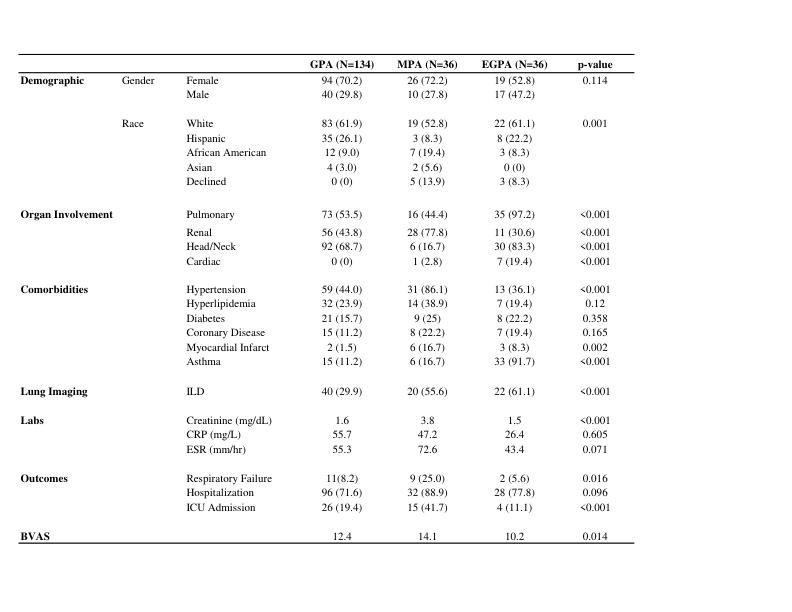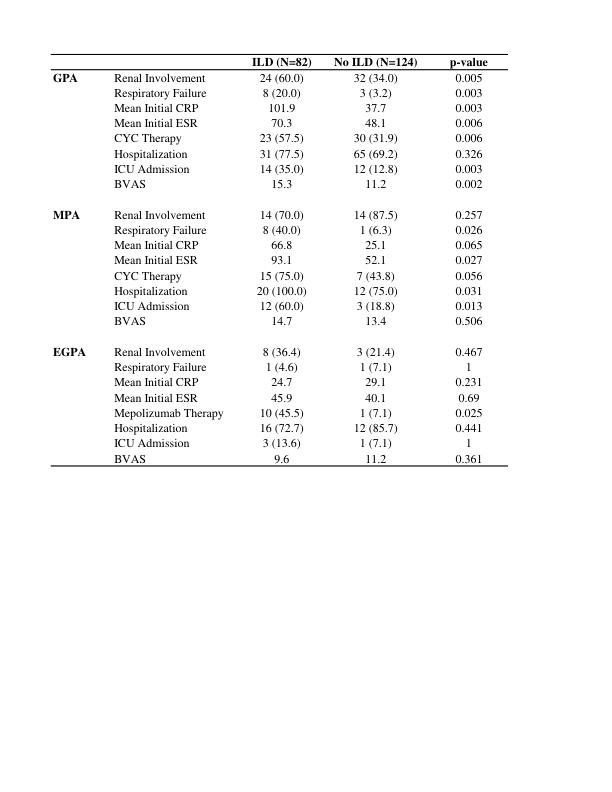Session Information
Session Type: Poster Session B
Session Time: 10:30AM-12:30PM
Background/Purpose: Interstitial lung disease (ILD) is a significant manifestation of antineutrophil cytoplasmic antibody (ANCA)-associated vasculitis (AAV), including granulomatosis with polyangiitis (GPA), microscopic polyangiitis (MPA), and eosinophilic granulomatosis with polyangiitis (EGPA). While the prevalence and impact of ILD in AAV have been studied, further investigation is needed to better understand its clinical characteristics, radiographic features, and outcomes. This study aims to characterize ILD in AAV patients and compare these findings with AAV patients without ILD at Rush University Medical Center (RUMC).
Methods: A retrospective cohort analysis was performed on adult AAV patients treated at RUMC from January 2010 to December 2021. Patients were identified using ICD-9/10 codes and confirmed according to the 2022 ACR/EULAR classification criteria. Inclusion criteria were adult patients (≥18 years) diagnosed with AAV (GPA, MPA, or EGPA) who had available medical records for review. Exclusion criteria included patients under 18 years of age and those not meeting the ACR/EULAR classification criteria. Clinical characteristics, radiographic findings, and outcomes were extracted from electronic medical records and analyzed using statistical tests to compare AAV patients with and without ILD.
Results: Of the 206 AAV patients included in the study, 82 (39.8%) had ILD. The prevalence of ILD was 29.9% in GPA, 55.6% in MPA, and 61.1% in EGPA. In the GPA group, patients with ILD had higher rates of renal involvement (60.0% vs. 34.0%; p=0.005), respiratory failure (20.0% vs. 3.2%; p=0.003), and ICU admissions (35.0% vs. 12.8%; p=0.003). In the MPA group, patients with ILD had higher rates of respiratory failure (40.0% vs. 6.3%; p=0.026) and ICU admissions (60.0% vs. 18.8%; p=0.013). In the EGPA group, patients with ILD were more likely to be treated with mepolizumab (45.5% vs. 7.1%; p=0.025). Although no statistically significant differences in mortality were observed between ILD and non-ILD groups, trends indicated worse outcomes for ILD patients.
Conclusion: ILD is a prevalent and severe manifestation in AAV, associated with increased rates of organ involvement, respiratory failure, and ICU admissions. The presence of ILD in AAV should prompt aggressive management strategies to improve patient outcomes. These findings underscore the importance of recognizing and treating ILD in AAV patients, highlighting the need for further research on diverse cohorts to enhance understanding and treatment.
To cite this abstract in AMA style:
Castellino J, Orentas M, Moran J, Fair J, Zhang Y, Bukiej A. Interstitial Lung Disease in ANCA-associated Vasculitis: A Retrospective Study of Clinical Characteristics, Radiographic Features, and Outcomes [abstract]. Arthritis Rheumatol. 2024; 76 (suppl 9). https://acrabstracts.org/abstract/interstitial-lung-disease-in-anca-associated-vasculitis-a-retrospective-study-of-clinical-characteristics-radiographic-features-and-outcomes/. Accessed .« Back to ACR Convergence 2024
ACR Meeting Abstracts - https://acrabstracts.org/abstract/interstitial-lung-disease-in-anca-associated-vasculitis-a-retrospective-study-of-clinical-characteristics-radiographic-features-and-outcomes/


